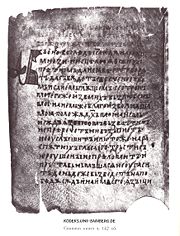
Sava's book
Encyclopedia

Early Cyrillic alphabet
The Early Cyrillic alphabet is a writing system developed in the First Bulgarian Empire in the 9th or 10th century to write the Old Church Slavonic liturgical language...
Old Church Slavonic
Old Church Slavonic
Old Church Slavonic or Old Church Slavic was the first literary Slavic language, first developed by the 9th century Byzantine Greek missionaries Saints Cyril and Methodius who were credited with standardizing the language and using it for translating the Bible and other Ancient Greek...
canon evangeliary, written in the eleventh century.
The original 126 parchment
Parchment
Parchment is a thin material made from calfskin, sheepskin or goatskin, often split. Its most common use was as a material for writing on, for documents, notes, or the pages of a book, codex or manuscript. It is distinct from leather in that parchment is limed but not tanned; therefore, it is very...
folios are of Bulgarian provenience, being bound into a larger codex with later additions of the Russian Church Slavonic recension. The codex is named the priest Sav(v)a, who inscribed his name on the two of the original folios, and on who there is no other historical record and is therefore believed to be one of the manuscript copyists.
The early history of Sava's book is not known. What can be ascertained is that the codex was in the Seredkino monastery near Pskov
Pskov
Pskov is an ancient city and the administrative center of Pskov Oblast, Russia, located in the northwest of Russia about east from the Estonian border, on the Velikaya River. Population: -Early history:...
till at least the 17th century. Afterward it was moved to the manuscript collection of the Moscow Synodal Priting House, where it was found in 1866 by the Russian Slavist Izmail Sreznevsky
Izmail Sreznevsky
Izmail Ivanovich Sreznevsky was a towering figure in 19th-century Slavic studies.His father, Ivan Sreznevsky, was a prolific translator of Latin poetry who taught at the Demidov Lyceum in Yaroslavl before moving to Kharkov University. It was in Kharkov that Sreznevsky graduated in philology and...
, who gave the codex its modern-day appellation and was the first one to publish it (Saint Petersburg, 1868). Today it's kept in the Central State Archive of Old Documents (CGADA) in Moscow.
The first critical edition of the manuscript was published by V. N. Ščepkin (Savvina kniga, Saint Petersburg 1903), photographically reprinted in Graz in 1959. Ščepkin was the first to indulge in the paleolinguistic analysis of the manuscript (Razsuždenie o jazyke Savvinoj knigy, 1899) and has ascertained that it was copied from Glagolitic
Glagolitic alphabet
The Glagolitic alphabet , also known as Glagolitsa, is the oldest known Slavic alphabet. The name was not coined until many centuries after its creation, and comes from the Old Slavic glagolъ "utterance" . The verb glagoliti means "to speak"...
original. His 1903 edition made N. Karinski to propound several new readings and fix a certain amount of wrong solutions (Perečenь važnejših netočnostei poslednego izdanija Savvinoj knigi, Izv., XIX, 3, 206-216). Paleographic and linguistic analysis shows that the copyist wrote yer
Yer
The letter yer of the Cyrillic alphabet, also spelled jer or er, is known as the hard sign in the modern Russian and Rusyn alphabets and as er golyam in the Bulgarian alphabet...
s there where he didn't pronounce them any more, and that behind č, ž and š he wrote ъ instead of ь, which indicates that the aforementioned consonants were pronounced "hard" in scribe's mother tongue. There is numerous evidence for the loss of epenthetic l, and instead of iotified a yat
Yat
Yat or Jat is the thirty-second letter of the old Cyrillic alphabet. Its name in Old Church Slavonic is jěd’ or iad’ . In the common scientific Latin transliteration for old Slavic languages, the letter is represented by e with caron: .The yat represented a Common Slavic long vowel...
is often written.

